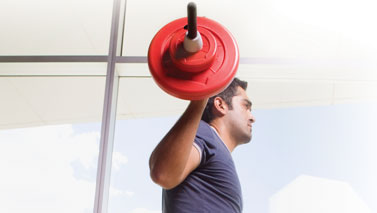In a country where 65 percent of adults are overweight, it can be tough to feel sorry for those who struggle to pack on the pounds. But, if you’re one of these folks, you know life in Lankyland can get downright discouraging. It’s tough to stay motivated when you can scarcely see the difference between lifting weights diligently and skipping the gym altogether. Where are the bulging muscles you hoped would result from those hours spent working out?
Aesthetics aside, added muscle can also improve sports performance in everything from jujitsu to triathlon. It can also help you avoid the metabolic pitfalls of being “skinny fat.” Yes, it turns out that even the slimmest among us can have shockingly high body fat, poor bone density and dangerously high LDL (“bad”) cholesterol levels.
But the concerns of those predisposed to thinness are not always well understood. Katie Wilkerson, 25, has always been leaner than she’d like, and she says she hasn’t received much sympathy for her challenges, or much good advice. “I’ve literally been told to go eat a Twinkie,” she says. “It’s as though people are angry I want to put on weight.”
Having learned from experience that cramming in junk food between meals wasn’t the answer, Wilkerson is now taking a more measured approach. “I’ve learned that gaining muscle takes working out properly and eating clean,” says the Austin, Texas, resident.
So far, that approach seems to be working for her. “I’ve recently gained about 2 pounds of pure muscle,” she says. “It might not sound like a lot, but I can tell a huge difference in how my clothes fit.”
Ectomorphic, “hardgainer” types like Wilkerson, characterized by their long limbs, short torso and thin muscles, may have trouble gaining muscle weight because of a variety of factors. Here are the most likely problems and the suggested solutions experts offer for working around them.
Problem—Insufficient calories.
Solution –To be certain they are consuming more calories than they’re burning, hardgaining ectomorphs should add a zero to their weight, says exercise physiologist Kelli Calabrese, MS, CSCS. “This provides you with the approximate number of calories you need just to maintain your current weight. In order to add muscle, you’ll want to consume an extra 300 to 700 calories, depending on how hard you’ve trained that day and how efficient your metabolism is.”
Just where those calories should come from is a matter of some debate, though. Most experts agree they should come from high-quality sources, and not junk. But some are big fans of animal-derived “complete” proteins (meat, eggs, dairy) that contain all the essential amino acids. Others suggest that a carefully crafted plant-based diet (vegetables, legumes, grains, nuts and fruits) can provide plenty of complete (and easily completable) proteins while offering some important health and nutritional advantages.
Animal proteins require a good deal of metabolic energy to break down before they can be assimilated. For this reason, and because they tend to put a greater toxic burden on the body, the net lean-tissue-building gain may actually be greater with a hearty plant-based diet, say experts like Bradley Saul, former pro cyclist and founder of OrganicAthlete, an international nonprofit organization that educates athletes in veganism.
One way to get enough plant-based calories is by incorporating a variety of calorically dense foods (like legumes, avocados, coconut, nuts, seeds, whole grains and oils) into your diet. Tofu, tempeh, miso, nut butters and ground hemp seed are more good protein and calorie sources.
Mark Sisson, CEO of Primal Nutrition, Inc., in Malibu, Calif., recommends all hardgainers strive for a daily protein intake of 1 to 2 grams per pound of body weight. “Then, add healthy fats, such as the monounsaturated and polyunsaturated fats from olive, fish or flaxseed oil. In many cases, 50 to 60 percent of calories should be from good fats,” he says.
Vegetarians might also consider supplementing their diets with amino acids to make enough of these basic muscle-building blocks available, says Calabrese.
“Add more to whatever you’re currently eating — an extra piece of fruit for breakfast, a side of quinoa for dinner, or a handful of nuts and dates as a snack,” advises Ryan D. Andrews, MS, RD, director of research at Precision Nutrition in Toronto, Canada.
Another option: adding a “wake and shake” during the night to prevent muscle catabolism that occurs during your nighttime fast. “If you can wake during the night and drink a shake with slow-digesting protein powder, then fall back asleep, that’s great,” says Chad Waterbury, MS, author of Muscle Revolution: The High-Performance System for Building a Bigger, Stronger, Leaner Body (self-published, 2007). But high-quality sleep far outweighs the benefit of late-night calories, he adds. If it throws off your sleep cycle, then this trick isn’t for you.
Problem—Training for too long.
Solution – Unless there’s a sports-specific reason you’re training, your whole workout — including cardio — should last no longer than 45 intense minutes, excluding warm-up time. “Research indicates that longer sessions lead to unfavorable changes to hardgainers’ testosterone-to-cortisol ratio,” says Eric Cressey, coauthor of Maximum Strength: Get Your Strongest Body in 16 Weeks with the Ultimate Weight-Training Program (De Capo, 2008). More of the stress hormone cortisol means more difficulty gaining muscle.
When you’re on the treadmill, set the incline to get more bang for your buck — you’ll work glutes, calves and quads more intensely. If cardio is a large part of your fitness regimen — that is, if you’re an endurance athlete — be sure to include extra calories in your diet to compensate.
Also, hardgainers shouldn’t lift on consecutive days. Back-to-back weight-training sessions can tax their nervous systems and diminish results. Try lifting intensely every other day for three weeks, incorporating an easier week, and then ramping back up for three more weeks of heavy lifting. This periodized approach will allow your body adequate time to repair muscles. (For more on periodization, see “Chart a Course to Fitness”.)
Problem—Weight workouts that are too specialized.
Solution: Hardgainers benefit more by creating strong, dense core muscles than by isolating smaller muscles. Waterbury recommends focusing on multijoint, multimuscle exercises such as squats, dead lifts and bench presses.
Problem—Low-resistance resistance training.
Solution – “Don’t fear lifting heavy weights,” says Calabrese. “When you lift heavier weights, the resulting muscle tissue is denser and provides you with the shape you’re working so hard to achieve.” That goes for women, too, she says.
To build a foundation of strength, says Cressey, focus on sets that feature fewer reps (three to five) and heavier weights. “When this strength is later applied to sets of six to 10 reps, it’s much easier to gain muscle size,” he says.
If you’re finding yourself exhausted when you do increase those settings, try resting not only between sets, but also between reps. That will replenish your body’s supply of adenosine triphosphate (ATP), an energy-rich chemical compound that provides the bulk of the energy your body requires to lift weights. (For more on this technique, see “Pause for Power”.)
Problem—Low human growth hormone.
Solution – “Lack of sleep can be a key reason for low human growth hormone (HGH) levels,” says Cressey. Make time to unwind before bed to reduce stress and increase your chances of a good night’s sleep. Nighttime is when growth hormone peaks, and without enough sleep, your muscles don’t have a chance to repair, recover and grow. Or, if you absolutely can’t find a way to snag more sleep, add one or two short sprint sessions a week (e.g., running stadium stairs) to stimulate HGH production.
OK, so maybe gaining muscle will never be easy for you. But if you commit now to following the advice you’ve gleaned here, by New Year’s Day you could be celebrating the end of your scrawny era.
Are You a Hardgainer?
According to Chad Waterbury, MS, author of Muscle Revolution: The High-Performance System for Building a Bigger, Stronger, Leaner Body (self-published, 2007), if you answer “yes” to all of the questions below, chances are good that you’re a hardgainer.
- Have you worked out diligently with weights for at least four weeks with little or no result?
- Do your fingertips overlap when you encircle your wrist? Do you have bony ankles and smaller-than-average calves?
- Do you struggle with insomnia? Or do you rouse easily during the night?
- Do you feel run-down after three to four weeks of intensive weight training? Are your workouts disrupting your normal sleep patterns? Have you noticed a sudden drop in your appetite?
Muscles for Endurance Athletes
Are you a triathlete, runner, cyclist or cross-country skier? For hardgainers who prefer endurance sports like these, here’s some good news: Your athletic preference doesn’t have to doom you to eternal scrawniness.
“Endurance athletes can definitely gain lean body mass and improve their power and strength,” asserts Amanda Carlson, MS, RD, director of performance nutrition and research for Athletes’ Performance and Core Performance in Tempe, Ariz. The key, she says — aside from good nutrition — is strength training on the side.
There are three main types of muscle fibers, she explains: slow-twitch (ST), fast glycolytic (FG) and fast oxidative glycolytic (FOG). ST fibers aid in endurance activities such as long-distance running. FG fibers are used in explosive activities such as weight training. And FOG fibers can develop either way, depending on how you train. “Strength training will help to improve, and result in hypertrophy [enlargement] of, FOG fibers,” says Carlson — “even in endurance athletes.”
Carla Birnberg is a fitness and lifestyle writer who edits the daily blog MizFit at www.mizfitonline.com.
This article originally appeared as “Critical Mass” in the October 2008 issue of Experience Life.




This Post Has 0 Comments